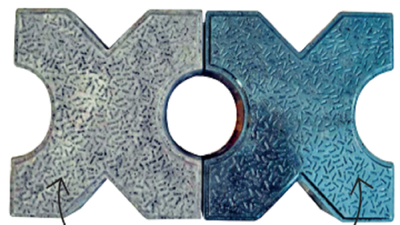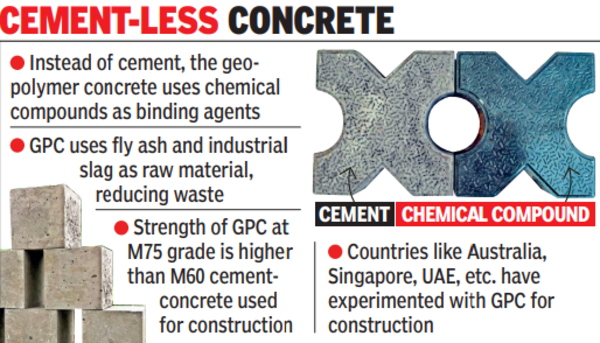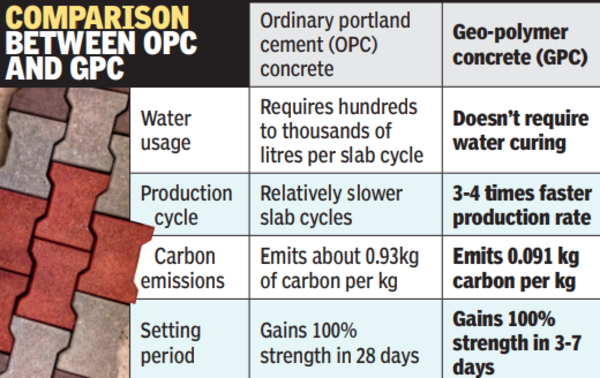- News
- City News
- ahmedabad News
- Ahmedabad: A concrete without cement that needs no water, has more strength
Ahmedabad: A concrete without cement that needs no water, has more strength

Cement chemical compound
AHMEDABAD: The ubiquitous concrete, quintessentially a mixture of cement and aggregate like sand or gravel, used in the construction industry just got a green makeover.
A faculty-student project at CEPT University has achieved success in making concrete without cement by using industrial waste by-products like fly ash or ground-granulated blast furnace slag (GGBS) with chemical binders (alkali activators) and aggregate. The researchers claimed that it sets in less time, needs no water for curing and has more compressive strength than the conventional concrete mixture.

Bhargav Tewar, assistant professor at Faculty of Technology of CEPT University, along with visiting faculty Nikunj Dave and students Shivam Soni and Krupansh Patel among others, worked on the studio project.
Bhargav Tewar, assistant professor at Faculty of Technology of CEPT University, along with visiting faculty Nikunj Dave and students Shivam Soni and Krupansh Patel among others, worked on the studio project and later directed research project (DRP) to explore the alternatives of cement-concrete.

"According to some estimates, cement production accounts for about 8% of the globe's carbon emission. Moreover, energy required to produce cement is next only to steel and aluminium and it uses a lot of water for curing to attain required strength," he said, adding that the search for alternatives led them to various permutations and combinations which eventually reached to fruition with a specific process.
The researchers have made blocks and pavers from the cement-less concrete - technically identified as geo-polymer concrete (GPC). "These, when tested on several parameters, performed better than expectations. For example, it has compressive strength more than M75 which is much higher than the regular M30-M40 grade of concrete being used in buildings. The grade of GPC concrete matches that of concrete being used for large infra projects such as Metro and Bullet train," said Prof Tewar.
Prof Tewar said that GPC and conventional concrete look the same. "Importantly, we have achieved the result at room temperature compared to a few global projects where the strength gain took place at high temperatures."
On the flip side, the team points at two aspects - it weighs a bit more than the cement-concrete and requires a production plant near the site. It's thus more suitable for pre-fabricated usage such as paver blocks even as further research is underway.
Prof Aanal Shah, acting dean of the Faculty of Technology, CEPT University, said that her doctoral research was on GPC, and world over the attempts are being made to find sustainable alternatives to cement. "More awareness about this material in the construction industry is needed. While countries like Australia have used the tech for building construction with separate code, it will take some time to fully understand its applications in the Indian context," she said.
A faculty-student project at CEPT University has achieved success in making concrete without cement by using industrial waste by-products like fly ash or ground-granulated blast furnace slag (GGBS) with chemical binders (alkali activators) and aggregate. The researchers claimed that it sets in less time, needs no water for curing and has more compressive strength than the conventional concrete mixture.

Bhargav Tewar, assistant professor at Faculty of Technology of CEPT University, along with visiting faculty Nikunj Dave and students Shivam Soni and Krupansh Patel among others, worked on the studio project.
Bhargav Tewar, assistant professor at Faculty of Technology of CEPT University, along with visiting faculty Nikunj Dave and students Shivam Soni and Krupansh Patel among others, worked on the studio project and later directed research project (DRP) to explore the alternatives of cement-concrete.

"According to some estimates, cement production accounts for about 8% of the globe's carbon emission. Moreover, energy required to produce cement is next only to steel and aluminium and it uses a lot of water for curing to attain required strength," he said, adding that the search for alternatives led them to various permutations and combinations which eventually reached to fruition with a specific process.
The researchers have made blocks and pavers from the cement-less concrete - technically identified as geo-polymer concrete (GPC). "These, when tested on several parameters, performed better than expectations. For example, it has compressive strength more than M75 which is much higher than the regular M30-M40 grade of concrete being used in buildings. The grade of GPC concrete matches that of concrete being used for large infra projects such as Metro and Bullet train," said Prof Tewar.
Prof Tewar said that GPC and conventional concrete look the same. "Importantly, we have achieved the result at room temperature compared to a few global projects where the strength gain took place at high temperatures."
On the flip side, the team points at two aspects - it weighs a bit more than the cement-concrete and requires a production plant near the site. It's thus more suitable for pre-fabricated usage such as paver blocks even as further research is underway.
Prof Aanal Shah, acting dean of the Faculty of Technology, CEPT University, said that her doctoral research was on GPC, and world over the attempts are being made to find sustainable alternatives to cement. "More awareness about this material in the construction industry is needed. While countries like Australia have used the tech for building construction with separate code, it will take some time to fully understand its applications in the Indian context," she said.
FOLLOW US ON SOCIAL MEDIA
FacebookTwitterInstagramKOO APPYOUTUBE
Start a Conversation
end of article









